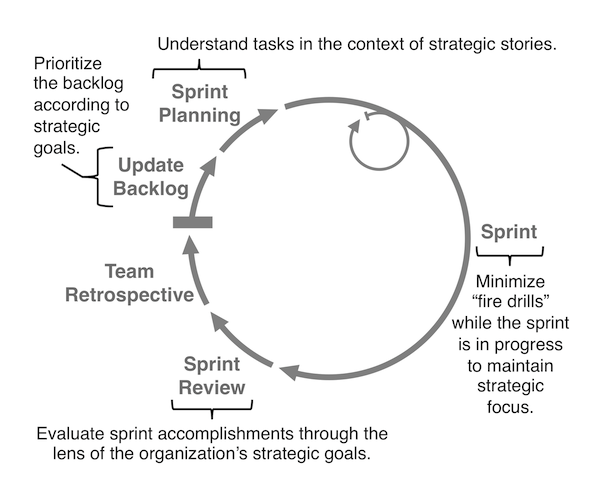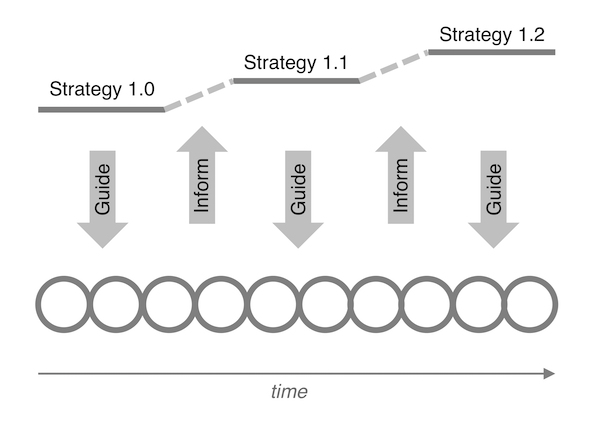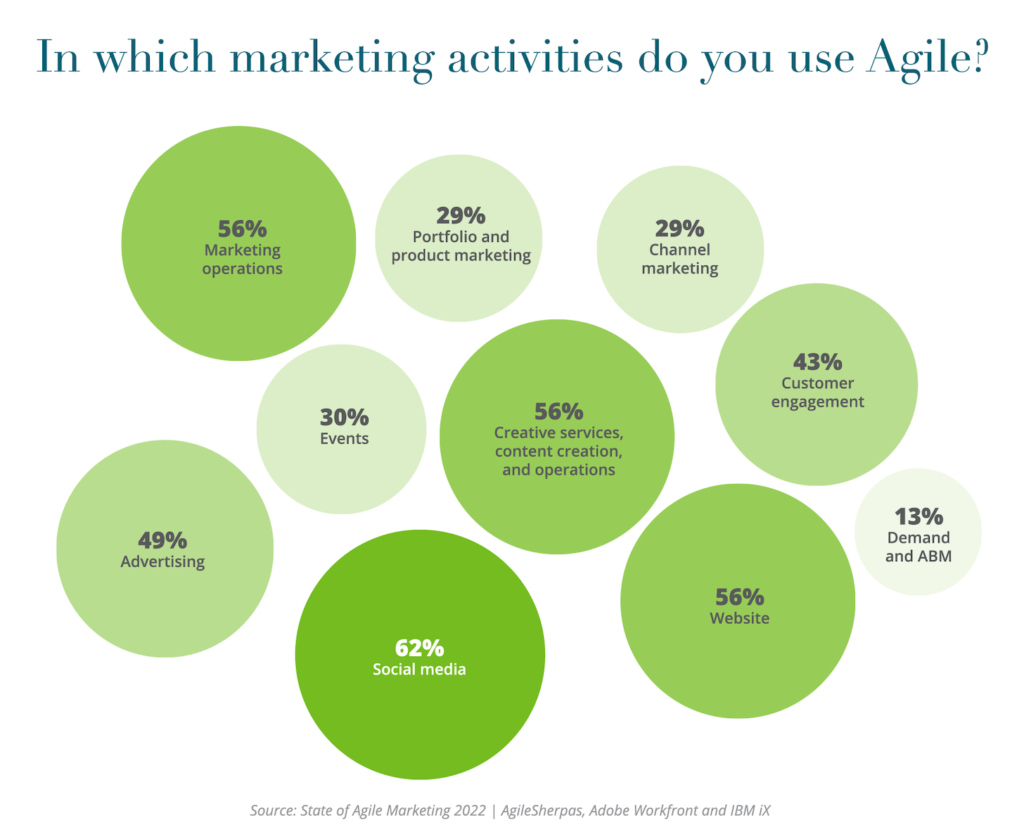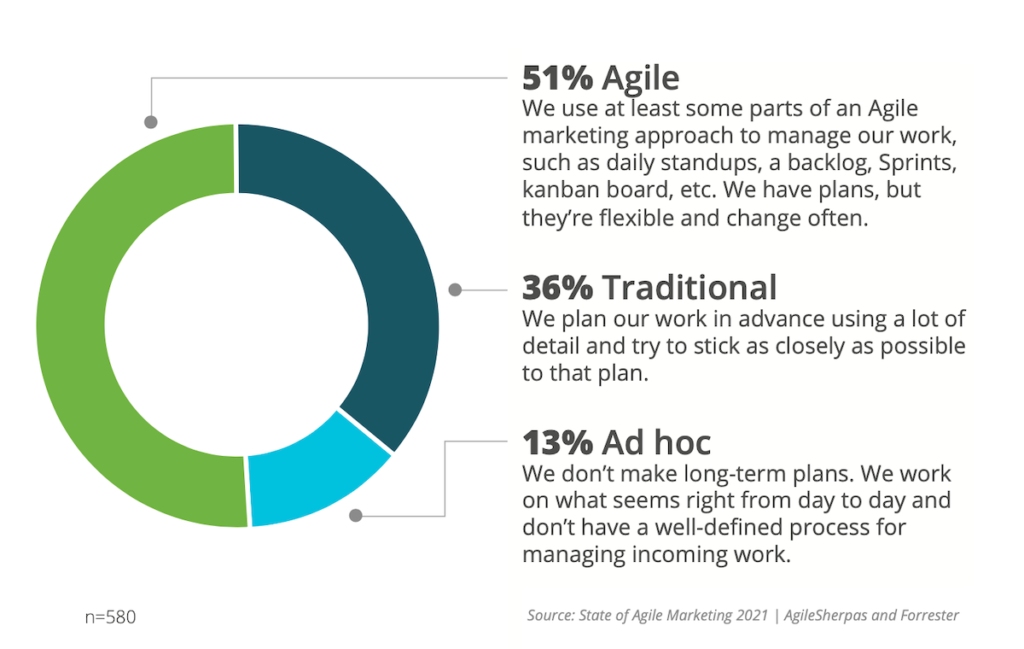“Agile marketing” is a crutch for those who do not have a real strategy.
That was the headline from an article published this week by Samuel Scott on The Drum.
Now, I’m a fan of The Drum. They generally have sharp coverage of marketing and media topics. I’m also a fan of Samuel in particular. His writing is punchy and makes you think.
But painting agile marketing and strategic brand leadership as polar opposites is a terrible mischaracterization of agile marketing.
I give him credit for calling BS on marketers who use abuse the term “agile” as a cover for a lack of strategic direction. If you’re just juggling a bunch of random tactics without any overarching strategy and calling it “agile” — you’re doing it wrong. (And, unfortunately, he’s probably right that too many marketers are.)
But if you think that’s what agile marketing is supposed to be, you’re mistaken.
Agile marketing amplifies strategy in a digital world
Agile management is not a strategy. Agile is an instrument of strategy.
Agile management is a way to execute a strategy when either (a) the environment in which you’re operating is fluid and shifting, and you want to rapidly sense and respond to those changes, or (b) the media in which you’re rendering your strategy is malleable and has fast feedback loops — hello, digital world — giving you the valuable option to iteratively optimize your execution quickly and cheaply.
Marketing today has both of those properties. What marketing executive wouldn’t want to harness those dynamics to outmaneuver and outperform their competition?
Of course, it still requires them to have a vision, a strategy, or — more flexibly — a set of strategic hypotheses. Without that, agile methods are a random walk. But when agile methods are connected to and governed by a clear strategy, agile optimizes the operational reality of that strategy beautifully.
As shown in the illustration at the top of this post, well-structured “sprints” — the short, one-week-to-one-month iterations in Scrum-style agile management — are intentionally designed to be closely tied to strategy:
- The backlog of things to be tackled by the team are continuously prioritized according to strategic goals. It’s a forcing function to make choices and trade-offs, and to paraphrase marketing strategy legend A.G. Lafley, strategy is choice.
- The sprint planning session at the beginning of each sprint frames the work selected to be done that cycle in the context of strategic stories and themes.
- The sprint itself resists interrupt-driven changes to the priorities being addressed in that cycle — if at all possible, postponing “fire drills” until the next sprint planning session, so that the team maintains its focus on the strategic work in progress.
- The sprint review at the end of the cycle evaluates what was accomplished in that sprint through the lens of the organization’s strategic goals — and provides valuable feedback back to the strategic leadership layer of the firm.
It’s important to note that agile marketing also supports strategic leadership bidirectionally. Agile relies on strategic oversight to guide its execution. But it also provides a mechanism to inform strategy of changes “on the ground” — detecting when strategy and reality diverge.
Agile generally doesn’t change strategy on a sprint-by-sprint basis. But it also doesn’t let a bad, outdated, or disrupted strategy go too far off course before providing empirical data necessary to make an informed correction.
Like it or not, modern marketing is entwined with software
Samuel’s frustration with “agile marketing” is expressed in a broader rejection of the idea that marketers should be software developers, which he seems to think was what I was advocating for in my book Hacking Marketing (which is largely about explaining agile marketing).
That wasn’t my argument.
Marketers don’t have to be software developers — a point I explicitly make in the book and have stated many times on this blog and in hundreds of presentations.
However, they are deeply dependent on the digital dynamics of software. So they should strive to understand those dynamics, both to inform their strategy and to create the right kinds of capabilities and organizational capital necessary to realize that strategy in a digital world.
And because software developers have been wrestling with those dynamics for 50 years — I’ve called them “the canaries in the digital coal mine” — it can be a smart idea to borrow proven management concepts from the software profession and adapt them to marketing.
Samuel seems annoyed by this though, writing, “Too many suit-and-tie marketers seem to loathe themselves, hate their jobs, and wish they were hoodie-wearing software developers instead. It is the only reason that I can surmise why the digital marketing world adopts so much of the trendy vocabulary of the high-tech industry without question.”
(As an aside, there’s something funny about that. When I was a kid, marketing — well, mostly advertising — was considered cool. Software development, which was what I was into, was not.)
Incorporating ideas from the software profession into marketing doesn’t inherently displace what marketing is all about or the myriad of strategic and operational approaches it brings to bear on its mission. Thinking it must is a false dichotomy. It simply augments them and updates them to today’s environment.
Marketers shouldn’t borrow ideas from the software world simply because of their software roots. But they shouldn’t reject them simply because of that ancestry either. Assuming that there’s nothing to be learned from an adjacent (and increasingly overlapping) profession is a reckless mindset — especially in an era of great change and upheaval.
Marketers who do that, ironically, are inadvertently borrowing a dangerous anti-pattern from the software profession that has plagued developers for decades: the hubris of “not-invented-here.”
P.S. For further reading on this subject, here are a couple of earlier articles I wrote that are relevant to this conversation: Pragmatic Marketing vs. Hype Cycles and False Dilemmas and 3 Myths of Agile Marketing.
P.P.S. Want to learn how to run agile marketing the right way? Sign up for Andrea Fryrear’s half-day workshop, Agile Marketing Advantage, at the upcoming MarTech conference in Boston, October 1-3. Here’s a peek at more of the agenda of the event, focused on the intersection of marketing, technology, and management.





I think you’re too caught up in the butthurt to realize Scott’s point, and really the core to each of his articles in the series. You fail to mention it here: the promotion mix. His concern is, how does agile really tie into the different channels marketers use? For some channels it is applicable, and others not. This isn’t about “not invented here”, he’s given reasoning as to why it generally doesn’t apply to this profession.
You talk about agile from a theoretical perspective, but that doesn’t fix the abuse, and you don’t align it with the promotional mix. Sam makes a point that it can end up being detrimental to companies who employ it. Can you show it’s value or ROI from a marketing perspective?
I don’t see how “Agile management is not a strategy. Agile is an instrument of strategy.” seems to invalidate his point. It’s eye roll inducing and doesn’t change the facts.
How does agile fit into the marketing channels, and how much more value does it provide over traditional processes?
Treating the misuse of a concept as the rationale to reject the concept as a whole strikes me as rash. If after everything you’ve read and seen, you adamantly don’t think agile is applicable to the marketing profession, then I won’t try to talk you out of that worldview in a comment thread.
No one is rejecting it as a whole. Sam explicitly says “agile can be useful in search engine optimisation, direct response and customer support.”
I’m just following it up with, how much more value does agile add to someone’s marketing efforts?
What do the fastest growing companies in the world have in common? Testing and iterating on those tests, shutting down the ones that don’t provide lift and overinvesting in the ones that do. That’s how Amazon can go from selling $0 in private label clothing to being the #2 retail brand in the world in less than a year.
Agile is simply the most efficient way of testing & learning. It doesn’t mean you shouldn’t have a brand strategy and it doesn’t mean you can’t have an ultimate set of goals in mind, but if you think that having all the answers to the test before you go-to-market than I’m afraid there will be some challenging days ahead as the pace of change and level of complexity in the world increases.